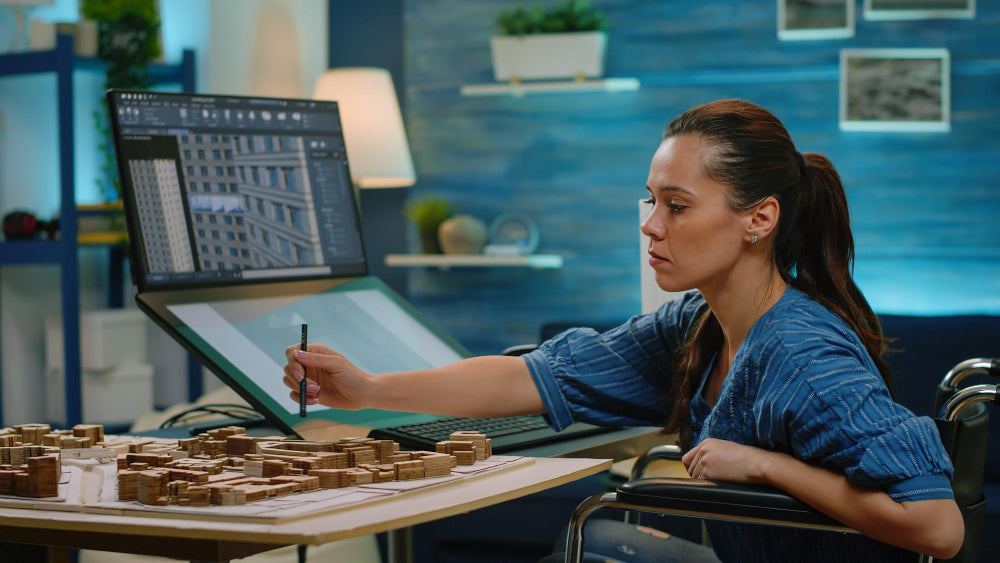Why is 3D Modeling Trending? Everything You Need to Know

Introduction
3D modeling has garnered a lot of hype in recent times and rightfully so. People from different industries have now become curious about 3D modeling and what it has to offer. As technology continues to advance, 3D modeling has become an indispensable tool for creative professionals, engineers, and innovators. From architects visualizing future buildings to game developers crafting immersive virtual worlds, 3D modeling has transcended its initial boundaries and now permeates numerous aspects of modern life. Whether you're a seasoned 3D artist looking to stay up-to-date with the latest trends or a curious beginner eager to explore the possibilities, this blog will serve as your comprehensive guide to the captivating world of 3D modeling and its endless potential. So, if you have ever found yourself searching about 3D modeling, you are in the right place. Here is everything you need to know about 3D modeling.
I. What is 3D Modeling?
3D modeling is a digital technique that allows designers and artists to create three-dimensional representations of objects, spaces, or characters. By manipulating vertices, edges, and surfaces, they bring virtual objects to life. This technology has evolved over the years, making it possible to create highly realistic and intricate models that once seemed impossible.
In 3D modeling, designers can start with simple geometric shapes and gradually refine them into complex and detailed structures. The process involves sculpting, extruding, and texturing to achieve the desired appearance and functionality. The advent of powerful computers and specialized software has significantly accelerated the 3D modeling process, enabling artists and engineers to bring their visions to fruition with remarkable precision.
The applications of 3D modeling extend far beyond the realms of art and design. From architecture and engineering to medical simulations and entertainment, the versatility of 3D models has transformed industries and revolutionized how we perceive and interact with virtual worlds. With the ability to render photorealistic scenes and create lifelike characters, 3D modeling has become a cornerstone of modern visual storytelling and simulation.
As technology continues to advance, we can only anticipate further advancements in 3D modeling techniques and tools. The future holds the promise of more intuitive interfaces, seamless integration with emerging technologies like virtual reality and augmented reality, and even greater accessibility for creators and consumers alike. Whether you're a hobbyist exploring your creativity or a professional pushing the boundaries of design, 3D modeling offers endless possibilities and a captivating journey of innovation and discovery.
II. Why is 3D modeling trending?
The trending popularity of 3D modeling can be attributed to a combination of factors. Advancements in technology, including powerful hardware, sophisticated software, and real-time rendering capabilities, have made 3D modeling more accessible and efficient than ever before. Its versatility across various industries, from architecture and product design to animation and medical simulations, has broadened its appeal and applications. Additionally, the rise of virtual reality (VR) and augmented reality (AR) has increased the demand for high-quality 3D models, as these immersive technologies rely on realistic visualizations. Social media and digital content platforms have also played a role, enabling artists to showcase their captivating 3D creations to a global audience. Moreover, the availability of educational resources and online communities has nurtured a supportive environment for aspiring 3D modelers, encouraging knowledge sharing and skill development. The influence of blockbuster entertainment with stunning visual effects further fuels curiosity and interest in 3D modeling. As this captivating field continues to evolve and expand, it promises to leave an indelible mark on various industries and shape the way we interact with digital content and virtual worlds. Furthermore, as the demand for immersive and interactive experiences continues to grow, 3D modeling will play a crucial role in shaping the future of entertainment, education, training, and even virtual social interactions, pushing the boundaries of what is possible in the digital realm.
III. Applications of 3D Modeling
A. In Architecture and Interior Design:
One of the primary applications of 3D modeling lies in the field of architecture and interior design. Architects and designers use 3D modeling to create realistic visualizations of buildings, rooms, and landscapes. With accurate representations, clients can gain a better understanding of the final outcome before construction begins. This streamlines the design process, reduces errors, and enables more effective communication with stakeholders.
B. In Product Design and Manufacturing:
3D modeling has revolutionized the product design and manufacturing industries. Designers can quickly create digital prototypes of products, test them virtually, and iterate on the designs before creating physical prototypes. This rapid prototyping saves time and money, ensuring that the final product meets the desired specifications. Additionally, 3D models aid in simulating the manufacturing process, allowing for a more efficient production line.
C. In Animation and Gaming:
The entertainment industry heavily relies on 3D modeling for creating captivating visuals in animations and video games. From characters and environments to special effects, 3D modeling brings these digital worlds to life. The level of detail and realism achieved through 3D models enhances the overall immersion and storytelling experience for audiences.
D. In Medicine and Healthcare:
The medical field has embraced 3D modeling to enhance surgical planning and medical education. By creating accurate 3D models of patient anatomy from medical imaging data, surgeons can strategize and practice complex procedures in a risk-free environment. Medical students also benefit from interactive 3D models, enabling them to understand human anatomy more effectively.
E. In Education and Training:
Educators and trainers leverage 3D modeling to create interactive and immersive learning tools. Whether in classrooms or online courses, 3D models allow students to explore subjects from different angles and perspectives. This experiential learning enhances comprehension and engagement, particularly in STEM (Science, Technology, Engineering, and Mathematics) subjects.
IV. Current Trends of 3D Modeling
A. Real-time Rendering:
Advancements in real-time rendering have transformed the way we visualize 3D models. The ability to render high-quality graphics in real-time has applications in gaming, architectural visualization, and virtual production. Realistic lighting, shadows, and reflections are now possible, providing an immersive and interactive experience for users.
B. Virtual Reality (VR) and Augmented Reality (AR):
The integration of 3D modeling with VR and AR technologies has opened up new possibilities in various industries. VR allows users to immerse themselves in virtual environments, while AR overlays digital objects onto the real world. These applications have found use in gaming, training simulations, virtual product showrooms, and even medical procedures.
C. Generative Design:
Generative design is an innovative approach that uses algorithms to explore numerous design possibilities based on defined constraints and objectives. This trend is gaining traction in architecture, product design, and engineering, as it produces optimized and efficient designs that may not be feasible through traditional methods.
D. Organic and Sculptural Modeling:
Advancements in sculpting tools have unleashed a new wave of organic and sculptural 3D models. Artists and designers can create fluid, lifelike shapes and characters with intricate details. This trend finds applications in industries such as entertainment, character design, and artistic expression.
E. Sustainable and Eco-friendly Modeling:
The increasing concern for sustainability has led to the adoption of eco-friendly 3D modeling practices. Designers now strive to create products and structures with minimal environmental impact. From sustainable architectural designs to eco-friendly consumer products, 3D modeling plays a vital role in promoting environmentally conscious solutions.
F. 3D Modeling for Web and E-commerce:
Online businesses have recognized the power of 3D modeling in enhancing the customer experience. Interactive 3D models enable users to inspect products from all angles, contributing to better-informed purchasing decisions. E-commerce platforms are adopting this technology to showcase products with greater detail and realism. Businesses have realized the potentials of 3D modeling in marketing and advertising of the products, as a result shaping E-commerce to a new direction.
G. Parametric Modeling:
Parametric modeling allows designers to create intelligent models by defining relationships between elements. Changes made to one aspect of the design automatically update related components. This approach is particularly valuable for complex and iterative design processes, enabling designers to make modifications efficiently.
H. Collaboration and Cloud-based Modeling:
Collaboration has become seamless through cloud-based 3D modeling platforms. Design teams can work together on projects in real-time, regardless of their geographic locations. This trend promotes the integration of global talent and diverse perspectives, leading to more innovative and inclusive projects.
I. 3D Printing Optimized Designs:
With the growth of 3D printing technology, designers are now optimizing models specifically for additive manufacturing. These designs consider factors such as material usage, structural integrity, and printability, resulting in more efficient and functional 3D-printed objects.
J. 3D Modeling for Medical Applications:
The medical field is witnessing remarkable advancements through 3D modeling. By creating patient-specific 3D models, surgeons can plan complex procedures with greater precision, leading to improved outcomes. 3D-printed surgical guides and customized medical devices are transforming patient care.

V. How to Make Money with 3D Modeling
A. Freelancing Opportunities:
For talented 3D modelers, freelancing platforms offer a plethora of job opportunities. Businesses and individuals seek skilled 3D modelers for various projects, ranging from architectural visualizations to product designs and character modeling for games and animations.
B. Selling 3D Models:
The growing demand for 3D models has led to the emergence of online marketplaces dedicated to selling 3D assets. There are websites which provide platforms for 3D modelers to showcase and sell their creations to a global audience. 3D modelers can directly sell their products to interested buyers through such market places and websites.
C. 3D Printing Ventures:
With the increasing popularity of 3D printing, there is a demand for unique and innovative 3D-printable designs. Entrepreneurs with 3D modeling skills can create and sell 3D-printable products, accessories, and customized items. These 3D printed models are popular in businesses for brand promotion and marketing purposes.
D. Collaborating with Industries:
Collaborating with businesses and industries that require 3D modeling services can be a lucrative venture. Whether it's creating 3D models for architectural firms, designing characters for game developers, or producing visualizations for marketing campaigns, the possibilities are diverse.
VI. The Future of 3D Modeling
The future of 3D modeling is promising, with several emerging trends on the horizon. Advancements in machine learning and artificial intelligence are expected to automate certain aspects of 3D modeling, reducing manual labor and streamlining the design process. Additionally, the integration of 3D modeling with emerging technologies like 5G connectivity and edge computing will enable real-time collaboration and remote rendering, unlocking new possibilities for global teamwork and seamless project execution.
The widespread adoption of 3D modeling will continue to impact various industries, leading to more innovative products, improved visualizations, and enhanced user experiences. 3D modeling will also find applications in fields we may not have even envisioned yet, transforming how we interact with technology and our environment.
As technology progresses, 3D modeling will become more accessible to a broader audience. Improved hardware, better software, and increased connectivity will empower individuals and businesses to leverage 3D modeling for various applications. Additionally, new industries may emerge as 3D modeling continues to revolutionize traditional processes.
VII. Conclusion
The journey through the world of 3D modeling has revealed its vast applications and the potential it holds for aspiring artists, designers, and entrepreneurs. From architecture to gaming, medicine to e-commerce, 3D modeling has woven itself into the fabric of modern-day industries. Moreover, the opportunities to earn a living through 3D modeling are diverse, whether by freelancing, selling 3D assets, or collaborating with businesses in need of 3D services.
As we look to the future, the ongoing developments in 3D modeling technology will undoubtedly bring even greater innovation and transformation to various fields. So, whether you're a professional seeking new adventures or a curious enthusiast eager to explore the limitless possibilities, embrace the 3D modeling revolution and let your imagination soar to new heights!
-
Posted in
3d modeling, Augmented reality, e-commerce, virtual reality




